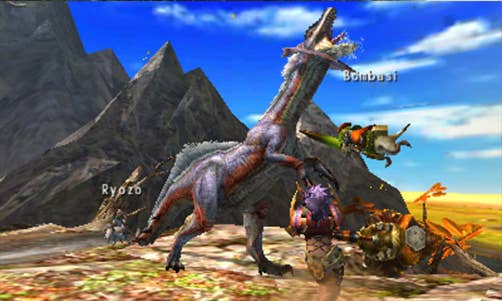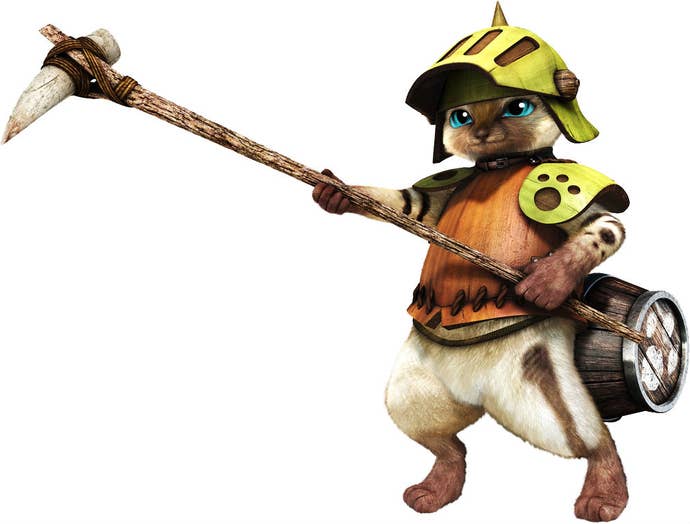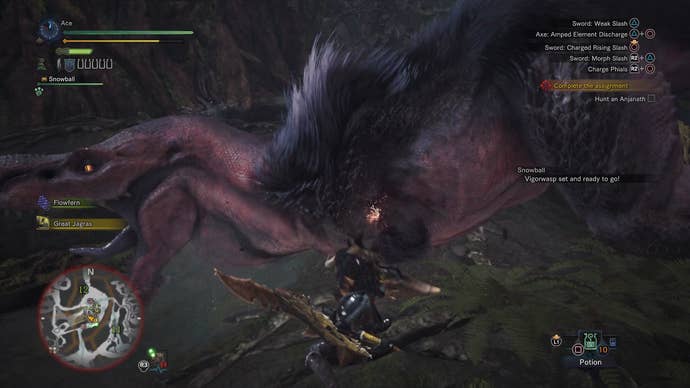How Monster Hunter Went From Japanese Phenomenon to Global Success
A true sense of community made Monster Hunter a giant in Japan, and now fans believe the time has come for Monster Hunter to take on the world.
This article first appeared on USgamer, a partner publication of VG247. Some content, such as this article, has been migrated to VG247 for posterity after USgamer's closure - but it has not been edited or further vetted by the VG247 team.
Not so long ago—a mere 15,000 years back, maybe—nothing made humans happier than gathering in close groups, taking up weapons, and strategizing how to track down, outsmart, and ultimately kill prey many times our size.
Here and now, we sit in artificially heated or cooled buildings while invisible data whizzes by our heads. If we're hungry, we hunt down a fast food restaurant. Modern conveniences are valuable, but it's still fascinating to look on documentaries following our ancestors as they conduct their yearly mammoth hunt. Back when food could take a bite out of you. Back when food-related mishaps involved crushed skulls and sliced tendons instead of a clerk forgetting to hold the pickles.

Capcom's incredibly popular Monster Hunter series soothes our shallowly-buried urge to hunt down huge and dangerous trophies without the risk of snapped femurs, gouged eyeballs, or whatever else our ancestors struggled to avoid. The 14-year-old series emphasizes strategy, teamwork, and craftiness. Most Monster Hunter games can be played alone and offline, but it shines as a cooperative online challenge that brings friends together, which is why the series is a phenomenon in Japan.
Monster Hunter's enormous appeal as a social pastime is also one of the main reasons it failed to catch fire in North America until quite recently. Now, non-Japanese fans of the series are hard at work trying to woo new tribe members and make them feel welcome with a warmth that's not seen often enough in the gaming community. As noticeable hype bubbles up around the release of Monster Hunter: World, it's clear at least some of their efforts are paying off.
Made in Japan for Japan
It's not hard to understand why Monster Hunter's been a slow burn in North America. Japan's densely-populated cities make it much easier for the country to collectively adopt a cooperative action game like Monster Hunter. North Americans are comparatively scattered across a sprawling continent. That makes finding fellow fans and getting together for some local monster-slaying a bit tough.

But while Japan received Monster Hunter's 2004 debut fondly and it eventually sold a million copies, the premiere game for the PlayStation 2 lacked the necessary mobility to make it white-hot. See, Monster Hunter has always been tailored for cooperative online play. The first game lets you hunt monsters and acquire items and weapons online that you won't find in the single-player experience (Monster Hunter's PS2 servers shut down in 2007, making official online play impossible). Monster Hunter has a lot in common with Phantasy Star Online, another title popular with Japanese players in the mid-aughts: Both games involve teams of up to four players facing off against colossal foes, and both games found dedicated fanbases in Japan, even though console-based online games had yet to achieve widespread popularity.
Once Capcom started looking at the smaller picture, however, Monster Hunter began its rampage across Japan's popular culture. It has yet to slow down.
Pocket Monsters on the PSP
If the PlayStation 2 is a sliver of land where Monster Hunter first tested its new wings, then the PlayStation Portable (PSP) is the series' undisputed territory and hunting ground. To hear people who were in Japan when Monster Hunter Freedom (2006) and Monster Hunter Freedom 2 (2007) came to the PSP, the games' popularity had to be seen to be believed. USgamer's own Kat Bailey was living in Japan when Monster Hunter went nuclear, and she recalls how playing Monster Hunter on your PSP with your friends and co-workers was simply something you just did, no questions asked.

That face-to-face camaraderie proved to be the real ticket for Monster Hunter. While the PSP can go online, Monster Hunter quickly became synonymous with the image of four people standing in a circle together, hunting, laughing, and having fun via a local connection.
Being shut out of a Monster Hunter circle was painful. A piece by Kotaku examining Monster Hunter's popularity in Japan has a noteworthy quote from a 25-year-old Japanese actor: "On a trip with 15 or so colleagues, everyone but me was playing Monster Hunter on their PSPs. I sat in the corner playing Final Fantasy on my PSP, while everybody else sat in circles of three or four laughing and having fun… It was terrible. When I got home, the first thing I did was get a copy of the game."
The article's author, Toshi Nakamura, goes on to observe how word-of-mouth also helped build up Monster Hunter's presence on the PSP and, later, the Nintendo 3DS.
"In Japan, a country with imperial origins, there is often enormous pressure to fit in in communities," he writes. "When something is popular among one's peers, it's best to get in on the action, or at the very least know what all the hubbub is about."
Nakamura also notes handheld systems have generally been more popular in Japan than anywhere else in the world, ultimately making Monster Hunter an accessible go-to franchise for quick and painless social gatherings.
Americans Learn to Love Monsters (With a Little Help From the Nintendo 3DS)
Monster Hunter wouldn't grow a sizable audience in North America until the Nintendo 3DS gained considerable momentum. Though the 3DS isn't seen nearly as often in the wilds of North America as it is in Japan, city dwellers could still count on getting at least a few StreetPasses on a good day during the height of the handheld's popularity. More people holding 3DSs equalled more people finally edging towards Monster Hunter. The 3DS's decent online infrastructure also helped more isolated North Americans get in on the action.
When it was time to translate Monster Hunter 4 Ultimate, Capcom first broke down the reasons why the series chronically underperformed outside Japan and aimed to address them. Capcom localization director Andrew Alfonso took special pains to make Monster Hunter 4 Ultimate (2015) as appealing for Western audiences as possible. He tightened the game's script and made it punchy, added skippable tutorials, and pushed the game hard on social media alongside tutorial videos. His work paid off; Monster Hunter 4 Ultimate finally sold over a million copies in North America and Europe. Its 3DS-based follow-up, Monster Hunter Generations, likewise "achieved solid sales".

Capcom's efforts haven't gone unnoticed by Monster Hunter fans like Sean from Texas. Sean found the series' early games tough to chew through, especially Monster Hunter Freedom 2 for the PSP. He eased into the later, more welcoming games, like Monster Hunter Freedom Unite (2009).
"It was impossible for Monster Hunter to be anything but niche back in the PSP days because the only way you could play with friends online was via apps like Ad-Hoc Party or Xlink Kai," he says. "Adding online play in console entries Tri and 3 Ultimate, but especially the portable 4 Ultimate at the peak of the 3DS's popularity, made the series a lot more accessible and pushed it into the Western gaming zeitgeist further than it's ever been. (...) They've also slowly improved the early game and tutorial functions in the games while still sticking to the series' idiosyncrasies, for better or worse."
Honor to the Old Guard
Even in those earliest years when Monster Hunter barely received a second thought from most of us, a small but fervent fanbase built up outside Japan, drawn in by the series' teamwork-based combat, item-crafting, and unusual levelling-up system focused almost exclusively around buff and debuff items, as well as weapon and armor upgrades.
Nobody understands this more than Yuri Araujo, a Capcom community specialist who entered Monster Hunter through the PlayStation 2 game and gradually ascended to the position of Capcom's "Monster Hunter boy."

"I can't remember exactly how long it took for everything to click [with the first Monster Hunter game] since it was so long ago, but at the time, I had a couple of friends that were already into Monster Hunter and were a bit ahead of me," Araujo recalls. "Their enthusiasm carried me through the beginning of the game as I played solo offline, but once we started playing online and I got to sever my very first Rathalos tail [Monster Hunter's iconic wyvern mascot monster], that's when I started to fall in love with Monster Hunter."
Araujo's appreciation for the series swelled when he observed how the games compliment one another. "My love for the series really solidified when I saw how everything connected: The Guild rules and guidelines for questing, the crafting of equipment relying mostly on monster materials, [and] the gameplay systems."
Even the weight of the attacks you execute against monsters have a comforting, almost addictive quality to them, Araujo says. "It took me no time to get drawn into the primitive feel of Monster Hunter."

Araujo also admits the designs of the series' titular monsters drew him in. That's understandable: Quarry in Monster Hunter heavily resemble dragons and formidable dinosaurs, but many still have endearing mannerisms. The Basarios, for example, is an immature (and therefore much smaller) Gravios (a wyvern monster with a stony hide), and it consequently bumbles more than its adult counterpart—not that it's incapable of skewering you if you go into battle with it unprepared. Monster Hunter is also famous for its "Felynes," a cat-like race that exudes adorable tenacity in a world filled with creatures much, much bigger than them.
"Visually I can appreciate [Monster Hunter is] never too gritty, allowing for outlandish creatures and cute cats to coexist seamlessly," says Davide Salvadori, a fan from Milan, Italy. "In a game that you could potentially play forever, breadth of visual style is very important."
Salvadori, who's been with the series since Monster Hunter Freedom Unite for the PSP (2009), also enjoys the franchise's' friendly atmosphere, which is fostered by a lack of overt competition with other players. "I feel [Monster Hunter's] co-op is inherently more engaging and friendly, making for [a compelling long-term] multiplayer experience," he says.
It may also be inaccurate to suggest early Monster Hunter games failed to pick up a sizable audience everywhere outside Japan. Billy Añonuevo from Manila in the Philippines got deep into the series with Monster Hunter Portable 3rd on PSP (2010), and he remembers there being a very robust fan community in his home city even back then.
"Since Metro Manila itself is a clump of densely populated cities and municipalities, it's fairly easy to organize offline co-op sessions. It's a far cry from the US where a lot of folks that want to play with each other live really far apart from each other," he says. "[Also], Filipino fans just happen to be innately and insanely passionate about things they love."

As for why Monster Hunter speaks to Añonuevo and his friends, it's simply about the thrill of the hunt—and the unique challenges presented by the series' unusual means of levelling-up. Unlike many action-adventure games, grinding for levels won't get you anywhere on the battlefield; everything depends on your skills.
"You're taking down creatures several dozen times your size and the beauty of it is that your equipment and stats can only get you so far," he says. "In the end, you're the one getting better at fighting all these magnificently-designed creatures, with your armor and weapons only there to augment your skills."
Hunters Wanted. Experience Not Necessary
Yet even as Monster Hunter finally catches on outside Japan, large numbers of potential players still look over to Monster Hunter: World for the PlayStation 4, Xbox One, and PC with wary eyes. Monster Hunter's reputation for being "hard to get into" precedes it. Even though the launch of Monster Hunter: World has people interested in the franchise, many hesitate to make their maiden hunt. "Should I give World a try?" they wonder. "Will I just waste the cost of admission on a game that overwhelms me within a few hours?"
Veteran Monster Hunter fans understand why new fish feel overwhelmed, and they're eager to make the games and the community as welcoming as possible. Whereas many popular online games develop reputations for communities that are cold, rude, and insular, Monster Hunter fans want as many people as possible to experience the joy of the hunt. There's even an "Adopt-a-Hunter" program that pairs up experienced players with newcomers who are interested in Monster Hunter: World, but still need to learn the ropes.

"Since 2004, the Monster Hunter community has grown and expanded to become one of the most inclusive, welcoming, and helpful online gaming communities that we have ever had the pleasure to be a part of," states the site's main page. "We hope to continue to not only preserve, but nurture that effort so that the Monster Hunter community as a whole continues to grow and be seen as a beacon of positivity in an otherwise bleak online gaming world."
Veterans are also eager to share their tactics with anyone who asks. Though there are ultimately many ways to skin a Blangonga, mastering Monster Hunter generally comes down to patience, persistence, and practice.
There's also a very easy way to get a feel for Monster Hunter: World's mechanics. "Play it solo offline," says Gerardo "Densuo" Santana from Brooklyn, New York, who's been with the series since Monster Hunter Freedom for the PSP. "I was able to scrap a basic set of armors and weapons simply by doing gathering quests. This will give you map knowledge, appreciation of skills that armor gives you, natural safe practice time against easier monsters, and a basic path to weapons and armor."
Santana also advises newcomers to take their time and not stress out about crafting the best weapons and armor right away. "Build early sets. You don't need the best immediately," he says. "You can build armor sets that keep you alive and provide great skills."

However you feel about Monster Hunter games, it's impossible not to admire the franchise's explosion in Japan, and its slow, stubborn, and ultimately successful efforts to gain more recognition outside its home borders. Veteran Monster Hunter fans are currently sharpening their weapons in preparation for the exact moment the sun touches Monster Hunter: World, but don't be afraid to talk to them. They've worked hard to spread the good word about the thrill of Rathalos-carving, and they'd love to have you along.
In fact, Yuri Araujo, nobility amongst Hunters, has one more piece of advice for fledglings.
"You can learn a lot just by observing monster behaviors before fully engaging in combat with them, and you can learn even more by starting the battle but focusing only on avoiding the monsters' attacks without attempting any counter-attacks," he says. "Remember: They’re bigger than you."
They sure are.









